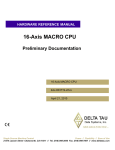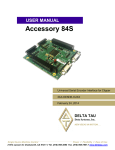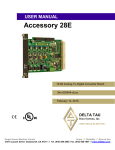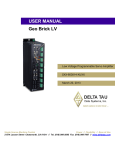Download 1^ USER MANUAL ^2 Accessory 70E
Transcript
1^ USER MANUAL ^2 Accessory 70E ^3 TAMAGAWA Encoder Interface Board ^4 300-603692-xUxx ^5 April 15, 2004 Single Source Machine Control Power // Flexibility // Ease of Use 21314 Lassen Street Chatsworth, CA 91311 // Tel. (818) 998-2095 Fax. (818) 998-7807 // www.deltatau.com Copyright Information © 2003 Delta Tau Data Systems, Inc. All rights reserved. This document is furnished for the customers of Delta Tau Data Systems, Inc. Other uses are unauthorized without written permission of Delta Tau Data Systems, Inc. Information contained in this manual may be updated from time-to-time due to product improvements, etc., and may not conform in every respect to former issues. To report errors or inconsistencies, call or email: Delta Tau Data Systems, Inc. Technical Support Phone: (818) 717-5656 Fax: (818) 998-7807 Email: [email protected] Website: http://www.deltatau.com Operating Conditions All Delta Tau Data Systems, Inc. motion controller products, accessories, and amplifiers contain static sensitive components that can be damaged by incorrect handling. When installing or handling Delta Tau Data Systems, Inc. products, avoid contact with highly insulated materials. Only qualified personnel should be allowed to handle this equipment. In the case of industrial applications, we expect our products to be protected from hazardous or conductive materials and/or environments that could cause harm to the controller by damaging components or causing electrical shorts. When our products are used in an industrial environment, install them into an industrial electrical cabinet or industrial PC to protect them from excessive or corrosive moisture, abnormal ambient temperatures, and conductive materials. If Delta Tau Data Systems, Inc. products are directly exposed to hazardous or conductive materials and/or environments, we cannot guarantee their operation. Accessory 70E Table of Contents INTRODUCTION .......................................................................................................................................................1 Layout Diagram.........................................................................................................................................................1 ACC-70E SETUP.........................................................................................................................................................3 PMAC – TAMAGAWA Encoder Data Address Select ............................................................................................3 Offset Register Mapping Definitions ....................................................................................................................3 ENCODER CONVERSION TABLE SETUP ...........................................................................................................5 Combine Single-Turn and Multi-Turn Data..............................................................................................................5 Sample PLC Program for Initialize Position........................................................................................................6 SERVO/PHASE CLOCK SELECTION ...................................................................................................................7 Battery Warning LED ...............................................................................................................................................7 Alarm Code ...............................................................................................................................................................8 Sample PLC for Alarm..........................................................................................................................................8 RESET ENCODER’S ABSOLUTE POSITION REGISTERS.............................................................................11 Sample PLC ............................................................................................................................................................11 JUMPER CONFIGURATIONS...............................................................................................................................13 E1 Turbo-PMAC/MACRO Select...........................................................................................................................13 E2 SYNC Clock Select............................................................................................................................................13 E6-E9 Request Signal Enable/Disable Select..........................................................................................................13 J10 Modified SYNC Pulse ......................................................................................................................................13 JEXP Pinouts...........................................................................................................................................................14 P1 JEXP (96-Pin Header) .................................................................................................................................14 JEXP Layout Diagram........................................................................................................................................15 CONNECTOR PINOUTS.........................................................................................................................................17 Connector J1 – Encoder 1 ......................................................................................................................................17 Connector J2 – Encoder 2 .......................................................................................................................................18 Connector J3 – Encoder 3 .......................................................................................................................................18 Connector J4 – Encoder 4 .......................................................................................................................................19 Connector Layout Diagram ................................................................................................................................19 TB1 – External Power Supply................................................................................................................................20 LED .........................................................................................................................................................................20 BOARD CONFIGURATION MEMORY MAP .....................................................................................................21 Bank ....................................................................................................................................................................22 Vendor Code .......................................................................................................................................................22 Option Code........................................................................................................................................................22 Revision ..............................................................................................................................................................22 Card Type ...........................................................................................................................................................22 Option Codes ......................................................................................................................................................22 Table of Contents i Accessory 70E ii Table of Contents Accessory 70E INTRODUCTION The TAMAGAWA interface card ACC-70E is a UMAC accessory card that connects to the UMAC CPU via a UBUS. The card is designed to handle two or four channels (add Option1). The Tamagawa interface protocol is a 2.5Mbps RS485 multi-drop style protocol that is designed to receive data serially from an encoder device. It supports encoders that return 17 bits of position data, 16 bits of multi-turn data and 8 bits of alarm data when Data ID3 data code is requested. This interface accessory card operates with FA-CODER TS5667N420-SA48 and FA-CODER TS5667N120-SA35. Addressability of the ACC-70E Tamagawa interface allows up to 16 cards (64 encoder channels) to be placed in the UMAC rack. Layout Diagram Introduction 1 Accessory 70E 2 Introduction Accessory 70E ACC-70E SETUP PMAC – TAMAGAWA Encoder Data Address Select Set up the address select sip switch S1 PMAC Chip Select Used Tamagawa Encoder Data Address CS10 CS12 CS14 CS16 Dip Switch SW1 Position 4 3 6 5 2 1 Y:$78C00-07 Y:$79C00-07 Y:$7AC00-07 Y:$7BC00-07 Closed Closed Closed Closed Closed Closed Closed Closed Closed Closed Open Open Closed Open Closed Open Closed Closed Closed Closed Closed Closed Closed Closed Y:$78D00-07 Y:$79D00-07 Y:$7AD00-07 Y:$7BD00-07 Closed Closed Closed Closed Closed Closed Closed Closed Closed Closed Open Open Closed Open Closed Open Closed Closed Closed Closed Open Open Open Open Y:$78E00-07 Y:$79E00-07 Y:$7AE00-07 Y:$7BE00-07 Closed Closed Closed Closed Closed Closed Closed Closed Closed Closed Open Open Closed Open Closed Open Open Open Open Open Closed Closed Closed Closed Y:$78F00-07 Y:$79F00-07 Y:$7AF00-07 Y:$7BF00-07 Closed Closed Closed Closed Closed Closed Closed Closed Closed Closed Open Open Closed Open Closed Open Open Open Open Open Open Open Open Open Offset Register Mapping Definitions Address Base + 00h Base + 01h Base + 02h Base + 03h Base + 04h Base + 05h Base + 06h Base + 07h ACC-70E Setup X –Memory 1st Channel 2nd Channel 3rd Channel 4th Channel Y-Memory Single turn data and alarms Multi turn data and alarms Single turn data and alarms Multi turn data and alarms Single turn data and alarms Multi turn data and alarms Single turn data and alarms Multi turn data and alarms 3 Accessory 70E 4 ACC-70E Setup Accessory 70E ENCODER CONVERSION TABLE SETUP Use the previous table and SW1 to select the address. Once the address is selected via the SW1, the corresponding address is used to read the encoder position data. Example: On all closed positions, the encoder conversion table entry will be: Set: I8000 = $678C00 I8001 = $11000 ; Y:$3501 ; Y:$3502 I8002 = $678C02 I8003 = $11000 ; Y:$3503 ; Y:$3504 I8004 = $678C04 I8005 = $11000 ; Y:$3505 ; Y:$3506 I8006 = $678C06 I8007 = $11000 ; Y:$3507 ; Y:$3508 Note: This is a two-line input for one encoder channel. Make sure the related I-Variable (Ix03, Ix04) is pointed to the address of the second line. For example, for the above set up: I103 and I104 should be = $3502. I203 and I204 should be = $3504. I303 and I304 should be = $3506. I403 and I404 should be = $3508. Combine Single-Turn and Multi-Turn Data The Tamagawa absolute encoder has two types of data—single-turn and multi-turn. A PMAC PLC program is used to combine the data and then copy it to an actual position register. Warning: If the actual position is changed while the motors are enabled, a runaway condition may occur which can cause machine damage or bodily injury. When changing the actual position register using a PLC program, make sure that the motors are not enabled. ACC-70E Setup 5 Accessory 70E Sample PLC Program for Initialize Position M138->X:$B0,18,1 M162->D:$8B M110->Y:$78C00,0,20,U M111->Y:$78C01,0,16,S ;#1 Open loop mode bit ;#1 Actual position(1/[Ixx08*32]) ;ENC1 Single turn data ;ENC1 Multi turn data M238->X:$130,18,1 M262->D:$10B M210->Y:$78C02,0,20,U M211->Y:$78C03,0,16,S ;#2 Open loop mode bit ;#2 Actual position(1/[Ixx08*32]) ;ENC2 Single turn data ;ENC2 Multi turn data OPEN PLC2 CLEAR IF(M138=1 AND M238=1) P162=M111*131072 P262=M211*131072 M162=(P162+M110)*(I108*32) M262=(P262+M210)*(I208*32) DIS PLC2 ENDIF CLOSE ;POS initialize PLC ;Make sure if motor ;Convert Multi turn ;Convert Multi turn ;Combine Multi turn ;Combine Multi turn ;Disable PLC 6 is open loop data for to cts data for to cts and single turn and single turn for for for for ENC1 ENC2 ENC1 ENC2 ACC-70E Setup Accessory 70E SERVO/PHASE CLOCK SELECTION Jumper E2 selects the servo or phase clock as the encoder request clock signal. With I-Variable setup such as I7m00, I7m01 and I7m02, clock frequency can be adjusted. Default servo clock frequency is 2.25kHz(442 us) and default phase clock frequency is 9.0khz(110us). Refer to the Turbo PMAC Software Reference manual on how to set up the servo or phase clock. ACC-70E is responsible for requesting and converting data from the encoder and the process is synchronized with either the servo or phase clock. The rising edge of the clock will trigger the start of the request. The whole process will take approximately 50us to 100us. Therefore, the positive pulse width of the clock must be set to greater than or equal to 100us in order to guarantee completion. If the positive pulse width is less than the process time for the Tamagawa encoder, it will send previously requested data. Within 2.2us after the rising edge, ACC-70E will fetch alarm data from the previous conversion and command the encoder to return position data. It takes 50us - 100us for the encoder to return the new position data. Battery Warning LED The interface board provides battery back up for the encoder. In addition, it has a battery voltage monitor circuitry that serves as a battery low warning. When the battery voltage drops to 2.3V, the red LED D1 will activate. Servo/Phase Clock Selection 7 Accessory 70E Alarm Code There are bit patterns of alarm code interpreted by the interface card. The following drawing shows the format of those bits. ALMC bits are data that is returned from encoder register DF7 when DATA ID 3 is requested. Sample PLC for Alarm M112->Y:$78C00,16,8,U M113->Y:$78C01,16,8,U OPEN PLC3 CLEAR P111=M113*$100+M112 IF(M113&$1=$1) SENDS"ALARM D0 ENDIF IF(M113&$2=$2) SENDS"ALARM D1 ENDIF IF(M113&$4=$4) SENDS"ALARM D2 ENDIF IF(M113&$8=$8) SENDS"ALARM D3 ENDIF IF(M113&$20=$20) SENDS"ALARM D5 ENDIF IF(M113&$40=$40) SENDS"ALARM D6 ENDIF IF(M113&$80=$80) SENDS"ALARM D7 ENDIF ;ENC1 ERR1 ;ENC1 ERR2 OS" FS" CE" OF" ME" BE" BA" IF(M112&$8=$8) SENDS"ALARM D24 CONTE" 8 Servo/Phase Clock Selection Accessory 70E ENDIF IF(M112&$10=$10) SENDS"ALARM D25 CRCE" ENDIF IF(M112&$20=$20) SENDS"ALARM D26 FOME" ENDIF IF(M112&$40=$40) SENDS"ALARM D27 SFOME" ENDIF IF(M112&$80=$80) SENDS"ALARM D28 TIOT" ENDIF I5311=10000*8388608/I10 WHILE(I5311>0) ENDW CLOSE Servo/Phase Clock Selection 9 Accessory 70E 10 Servo/Phase Clock Selection Accessory 70E RESET ENCODER’S ABSOLUTE POSITION REGISTERS The absolute and multi-turn data position registers can be reset to zero. When resetting the single-turn resister to zero, only the MSB 11 bits will be cleared. The remaining six LSB bits are not cleared. When resetting the absolute position registers in the encoder, reset the single-turn data before resetting the multi-turn data. To reset absolute position, write 00 to the base address 12 times for the single-turn reset. To reset the multi-turn data register, write 00 to the base address +1 (also 12 times). Sample PLC Y:$78C00 Y:$78C01 Y:$78C02 Y:$78C03 Y:$78C04 Y:$78C05 Y:$78C06 Y:$78C07 ; ; ; ; ; ; ; ; Channel#1 Channel#1 Channel#2 Channel#2 Channel#3 Channel#3 Channel#4 Channel#4 single turn data with SW1 default setting. multi turn data with SW1 default setting. single turn data with SW1 default setting. multi turn data with SW1 default setting. single turn data with SW1 default setting. multi turn data with SW1 default setting. single turn data with SW1 default setting. multi turn data with SW1 default setting. OPEN PLC1 CLEAR WHILE(P501<12) CMD"WY:$78C08,0" P501=P501+1 ENDW P501=0 I5111=20*8388608/I10 WHILE(I5111>0) ENDW WHILE(P501<12) CMD"WY:$78C09,0" P501=P501+1 ENDW P501=0 DIS PLC1 CLOSE Reset Encoder’s Absolute Position Registers ;Execute reset sequence 12 times ;Zero reset channel#1 single turn data ;20msec timer ;Zero reset channel#1 multi turn data 11 Accessory 70E 12 Reset Encoder’s Absolute Position Registers Accessory 70E JUMPER CONFIGURATIONS E1 Turbo-PMAC/MACRO Select Position E1 Setting Function 1-2 Default 3-4 Turbo 3U PMAC CPU Macro 3U CPU E2 SYNC Clock Select Position E2 Setting Function 1-2 2-3 Default Use phase clock as encoder request signal Use servo clock as encoder request signal E6-E9 Request Signal Enable/Disable Select Position E6 E7 E8 E9 Setting Function On Default Off On Default Off On Default Off On Default Off Enable request signal for Channel 1 Disable request signal for Channel 1 Enable request signal for Channel 2 Disable request signal for Channel 2 Enable request signal for Channel 3 Disable request signal for Channel 3 Enable request signal for Channel 4 Disable request signal for Channel 4 J10 Modified SYNC Pulse Position J10 Jumper Configurations Setting Function On Off Default Enable modified sync pulse Disable modified sync pulse 13 Accessory 70E JEXP Pinouts P1 JEXP (96Pin Header) Front View Pin # Row A Row B Row C 1 +5Vdc +5Vdc +5Vdc 2 GND GND GND 3 BD01 DAT0 BD00 4 BD03 SEL0 BD02 5 BD05 DAT1 BD04 6 BD07 SEL1 BD06 7 BD09 DAT2 BD08 8 BD11 SEL2 BD10 9 BD13 DAT3 BD12 10 BD15 SEL3 BD14 11 BD17 DAT4 BD16 12 BD19 SEL4 BD18 13 BD21 DAT5 BD20 14 BD23 SEL5 BD22 15 BS1 DAT6 BS0 16 BA01 SEL6 BA00 17 BA03 DAT7 BA02 18 BX/Y SEL7 BA04 19 CS3BA06 CS220 BA05 BA07 CS421 CS12BA08 CS1022 CS16BA09 CS1423 BA13 BA10 BA12 24 BRDBA11 BWR25 BS3 MEMCS0BS2 26 WAITMEMCS1RESET 27 PHASE+ IREQ1SERVO+ 28 PHASEIREQ2SERVO29 ANALOG GND IREQ3ANALOG GND 30 -15Vdc PWRGND +15Vdc 31 GND GND GND 32 +5Vdc +5Vdc +5Vdc For more details about the JEXP, see the UBUS Specification Document. 14 Jumper Configurations Accessory 70E JEXP Layout Diagram Jumper Configurations 15 Accessory 70E 16 Jumper Configurations Accessory 70E CONNECTOR PINOUTS The DB15 style connectors on the ACC-70E are described as J1 Top, J2 Top, J1 Bottom and J2 Bottom. The top connectors have the encoder signals for encoders 1 and 4 and the bottom connectors have the encoder signals for encoders 2 and 3. Connector J1 – Encoder 1 Pin# Symbol Function Description 1 2 3 4 5 6 7 8 9 10 11 12 13 14 15 GND DATA + CLOCK +5V BATTERY + Reference Input Output Output Output N/A Chassis Chassis Reference Input Output Output N/A N/A Chassis +5V and battery return Encoder data + Encoder request signal clock out + Connector Pinouts CASE GND CASE GND GND DATA CLOCK + +5V CASE GND 3.6V battery voltage out +5V and battery return Encoder data Encoder request signal clock out - 17 Accessory 70E Connector J2 – Encoder 2 Pin# Symbol Function Description 1 2 3 4 5 6 7 8 9 10 11 12 13 14 15 GND DATA + CLOCK +5V BATTERY + Reference Input Output Output Output N/A Chassis Chassis Reference Input Output Output N/A N/A Chassis +5V and battery return Encoder data + Encoder request signal clock out + CASE GND CASE GND GND DATA CLOCK + +5V CASE GND 3.6V battery voltage out +5V and battery return Encoder data Encoder request signal clock out - Connector J3 – Encoder 3 18 Pin# Symbol Function Description 1 2 3 4 5 6 7 8 9 10 11 12 13 14 15 GND DATA + CLOCK +5V BATTERY + Reference Input Output Output Output N/A Chassis Chassis Reference Input Output Output N/A N/A Chassis +5V and battery return Encoder data + Encoder request signal clock out + CASE GND CASE GND GND DATA CLOCK + +5V CASE GND 3.6V battery voltage out +5V and battery return Encoder data Encoder request signal clock out - Connector Pinouts Accessory 70E Connector J4 – Encoder 4 Pin# Symbol Function Description 1 2 3 4 5 6 7 8 9 10 11 12 13 14 15 GND DATA + CLOCK +5V BATTERY + Reference Input Output Output Output N/A Chassis Chassis Reference Input Output Output N/A N/A Chassis +5V and battery return Encoder data + Encoder request signal clock out + CASE GND CASE GND GND DATA CLOCK + +5V CASE GND 3.6V battery voltage out +5V and battery return Encoder data Encoder request signal clock out - Connector Layout Diagram Connector Pinouts 19 Accessory 70E TB1 – External Power Supply Pin # Signal Description 1 2 -BATT +BATT Note For external power supply For external power supply LED Name D1 D2 20 Description Battery low Power good Color RED RED Note Turn off normally Turn on normally Connector Pinouts Accessory 70E BOARD CONFIGURATION MEMORY MAP The board configuration memory mapping for Turbo UMAC models contains data pertaining to the configuration of products that are plugged into the UBUS backplane. On power-up or at any time, the UBUS processor (normally a Turbo UMAC processor) is capable of polling this block of memory to establish the mapping of hardware. Each block of memory contains four address locations that may be polled. There are two banks of four address locations that may be selected so that the processor can read data from up to eight address locations. 23 22 21 20 19 18 17 16 15 14 13 12 11 10 9 8 7 6 5 4 3 2 1 0 BASE VENDOR CODE +1 BANK BANK 0 +2 OPTION CODE +3 BASE REVISION +1 BANK BANK 1 CARD TYPE +2 +3 Board Configuration Memory Map 21 Accessory 70E Bank Place a 0 into this bit to select Bank 0. Place a 1 into this bit to select Bank 1. Vendor Code Delta Tau Data Systems, Inc. products will have a 1 in this 4-bit address field. Products from other companies will have other values returned in this field. Option Code This 5-bit field contains data that pertains to options that are installed on the accessory card. Each product will have a different meaning to the data in this field. Revision This 4-bit field indicates the revision level of the board assembly. Usually, this value is hard coded in the circuitry of the board fabrication. Card Type This 14-bit address field contains information pertaining to a part number assigned to the board. Usually, this value relates to a vendor’s board assembly part number. Delta Tau Data Systems, Inc. uses their 6digit part number converted to hexadecimal in this field. Option Codes The CS10, CS12, CS14 and CS16 selects that are used for the ACC-70E and I/O cards allows for up to 16 board configuration slots to be used. The dip switch selects between any of the 16 banks of memory. This allows up to 16 ACC-70Es to be logically configured. 22 Board Configuration Memory Map









































